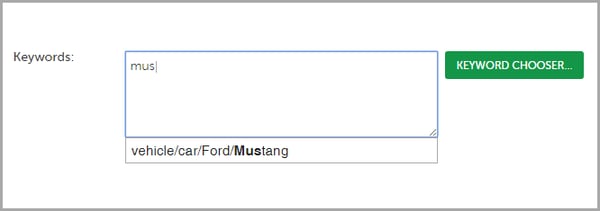
Hierarchical keywords & synonyms
What are hierarchical keywords?
The idea here is that many keywords belong to a larger categorisation structure. For example, if you were in the automotive industry and had many images of cars, then you could tag an image with the following keyword:
‘Mustang’
However, if you had a structure that already included this in a classification (as it is a common term for your particular industry) then by adding this one keyword, you would actually get the following:
vehicle, car, Ford, Mustang
That’s four for the price of one! Much better.
This would happen because there is a keyword hierarchy defined as follows:
vehicle > car > Ford > Mustang
So, in this case, you get the keyword you enter, plus all of the other keywords in the path from this tag upwards.
This is actually how it looks in Asset Bank as a user starts to type in a keyword. The auto-complete suggestion shows the keyword plus the additional tags in the hierarchy that will be added.

Hierarchical keyword auto-complete in Asset Bank
If instead you just had an image of a car that you knew was a Ford, but couldn't work out the model, then tagging it with
‘Ford’
would give you the following keywords:
vehicle, car, Ford
Where do synonyms come in?
A synonym is a word or phrase that means exactly or nearly the same as another word or phrase in the same language.
For the purposes of DAM, users often search on a thing but describe it slightly different based on their background, the country the are in, etc. So to strengthen your existing keyword structure, you can add synonyms at any level.
So for example, you may have the following:
person > male > man
With the following synonyms in place:
person - human
man - guy, gentleman
So, in this case, tagging an image with the word
‘man’
Will actually generate the following searchable tags:man, male, person, guy, gentleman, human
So six search terms for the price of one. Even better.What about plurals and other similar words?
In Asset Bank we make use of a stemming algorithm to take care of this. So, for example, if you tag an asset with the word
‘smile’
The stemming algorithm will automatically match this with the following:
smiles, smiling
Let’s see this all in action
For the following image, the tags in the first column are what the uploader added, the other columns show the other tags added automatically in the background by Asset Bank, as a result of the keyword/synonym structure and stemming algorithm.


What if we do not get it right first time?
In Asset Bank there is a 'failed searches' report that reveals which search terms resulted in zero matches. Admin users should review this periodically and act accordingly. This typically results in the admin user either:- Adding synonyms to existing keywords, or otherwise updating the hierarchical keyword structure (e.g. adding 'guy' as a synonym for 'male')
- Uploading the content that users were looking for (e.g. uploading presentations from a recent Sales Conference)
A sample structure
To get you started, you contact us for a sample hierarchical keyword structure (including synonyms) for Asset Bank.
Summary
Creating a hierarchical keyword structure, complete with synonyms, for terms related to your particular organisation is definitely worth doing. It will increase the effectiveness of your tagging and make it easier to find assets.


